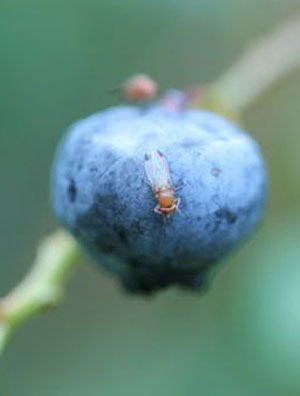Several Alternatives Available and in the Pipeline for SWD
Researchers have made significant strides in developing control strategies for spotted-wing drosophila (SWD) in the dozen or so years since it was first found in Oregon, according to Oregon State University entomologist Vaughn Walton. And they are about to embark on a new strategy that could dramatically lower control costs.
“A lot of us are very excited about biocontrol,” Walton said during a presentation at the Oregon Blueberry Conference, February 14 in Salem. “If this succeeds, we think it is going to significantly reduce the cost of managing for spotted-wing drosophila.”
The strategy involves rearing and releasing a natural enemy of the pest.
 |
Researchers recently received a permit from the USDA Animal and Plant Health Inspection Service to rear and release the parasitoid wasp, Ganaspis brasiliensis, and they plan to begin doing so during this cropping season, Walton said. “We will be rearing and releasing these parasitoids here in Oregon, as well as on the East Coast and other areas on the West Coast.
The wasp, which is very host specific, has been shown to reduce SWD populations by 65 percent, Walton said, by laying eggs inside the drosophila’s larvae.
Researchers found the wasp in South Korea in 2011 and have been working behind the scenes since then on finding populations of the parasitoid in the U.S. and in measuring its efficacy for controlling spotted-wing drosophila.
Walton said it could be a few months to a few years before the wasp builds up to population levels that are high enough to provide some control of the SWD. But when they do, relief should be significant.
“They are very specific and they should be self-perpetuating, which will hopefully provide quite a lot of relief to growers,” he said.
Walton said the biocontrol will be a good addition to the several softer technologies for controlling SWD, some of which are currently available, others of which are still in the pipeline.
“After twelve years, I think we are in a place where we are starting to have true IPM where people can start sampling, and when they find damage, they have softer alternatives available,” Walton said.
Included among technologies that Walton discussed is one that thickens the outer layer of blueberries, making it less attractive to the SWD. “What we are doing is adding wax to the berry,” he said. “There has been a lot of work done on this in the past where if you add an extra waxy layer on the surface of the berry, you can reduce your egg laying.”
Berries treated with the product, called Hydroshield, look and taste exactly the same as untreated berries, Walton said. Hydroshield is not yet registered for use on blueberries in the U.S.
An additional product produced by a German company is a feeding stimulant that can be added to a tank mix that is designed to increase the rate that the drosophila takes up a pesticide. “You can mix it in your tank, the insect lands on the residue, it feeds and it takes up the toxicant," Walton said.
“The results that are being shared with us through papers and through literature from the company is you can potentially use this product as a compound to significantly reduce your pesticide use,” Walton said.
Walton noted U.S. producers to date don’t have a use permit for the product, but that the product is in the IR-4 registration process, so could soon be registered.
Another technology he discussed, one called Decoy, draws the drosophila away from fruit to a slurry placed in fields at a rate of 50 dispensers per acre. Data from multiple locations in Oregon, California and Mexico has shown up to 75 percent reduction in drosophila damage under commercial production conditions.
Decoy is registered as a 25b (minimum risk insecticide) in Western states and is commercially available.
Walton also discussed sterilants, noting, “A sterilant, like peroxyacetic acid (currently registered for use in blueberries), is another option that is relatively clean technology that is not really toxic to any organisms.”
Vaughn Walton |
“We have our pesticides, but we also have other softer alternatives; We have sterilants, we have behavior disruptors, cuticle supplements and we will be having some biocontrol agents, as well.”
Walton added that when using pesticides, it is important to properly time applications at life stages where pesticides are most effective.
“With something like Spinosad or spinetoram you are going to be killing your larvae inside those berries very efficiently,” he said. “There are other compounds, like zeta-cypermethrin, that are not very efficient at killing some of the immature larval stages.”
He said it is also important to consider using tank mixes when targeting the drosophila.
“On their own, some pesticides, such as novaluron and acetamiprid, don’t do well in terms of controlling spotted-wing drosophila,” he said. “But combined, you are getting a compound that gives you really good control.
“So, timing of pesticides and selection of certain compounds is really important,” he said.